Variety of fish feed ingredients are available in Bangladesh. A major portion of this ingredients are obtained from different plants. Different parts of plant body are used as fish feed. Plant origin feed ingredients are comparatively cheaper than animal origin fish feed ingredients like fish meal, bone meal etc. and also contains less protein than those animal origin ingredients. However considering the economic capability of most of the fish farmers in Bangladesh, plant origin feeds ingredients are considered suitable for aquaculture.
Some common ingredients:
Some common fish feed ingredients which are originated from plant sources are- Maize bran, Suji, Rice flour, Rice bran, Rice polish, Wheat flour, Wheat bran, Sesame oil cake, Soybean grits, Mustard oil cake, Coconut oil cake, Lentil bran, Molasses etc.
Most of the plant origin fish feed ingredients are obtained from seeds of the plants. These plant ingredients can be grouped under heading bran, oil cake, flour, and others. Bran group includes rice bran, wheat bran, lentil bran etc. whereas oil cake group includes mustard oil cake, coconut oil cake, sesame oil cake etc. Oil cakes are obtained after processing of oil from the seeds. Flour group members are rice flour, wheat flour etc. and other ingredients are molasses, suji etc.
Plant origin fish feed ingredients are mostly of less protein containing ingredients except oil cakes. Except these oil cakes almost all other plant origin ingredients are considered as basal or energy supplement (i.e. contains less than 20% protein) such as maize bran (12.20%), rice bran (10.26%), wheat bran (12.91%) etc.
However some oil cake contains relatively high protein percentages and considered as protein supplement (i.e. contains more than 20% protein) such as mustard oil cake (30.33%), sesame oil cake (27.2%) etc.
Plant origin fish feed ingredients are varied considerably in shape and size. They may be powder like or solid irregular shaped. Feed particle size also varied greatly and as carnivorous fish species demand a very high level of protein, direct application of plant origin ingredients is found mainly in carp (herbivore or omnivore) polyculture farming system. These ingredients are used in feed industries as raw materials for making high protein-leveled fish feed by mixing with other ingredients and marketed in packed condition which are vigorously being used in commercial fish farms. As many of these ingredients can be made at home and available in rural or remote areas, for this, fish farmers from those areas used to feed their fish-stock with these ingredients.
.

01. Maize bran
Bangla name: Bhuttar Kura
English name: Maize bran
Source:
Corn/Maize plant (Zea mays)
Used part:
Seed
Physical properties:
Powder like and yellowish in color.
Chemical properties:
Protein 12.20%, Lipid 7.60%, Carbohydrate 60.40%, and Ash 2.40% (Das, 1997).
Availability:
Available all over Bangladesh and peak season is in the month between April and May.
Application:
By mixing with other feed ingredients. Mainly used in carp polyculture.
.
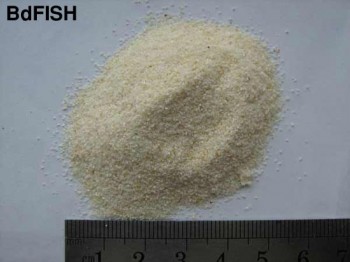
02. Suji
Bangla name: Suji
English name: –
Source:
Paddy (Oryza sativa)
Used part:
Seed
Physical properties:
Granular in form and whitish in color.
Chemical properties:
Protein 10.40%, Lipid 0.60%, Carbohydrate 74.80%, Calcium 16.0 mg/100 g, Phosphorus 102 mg/100 g, Iron 1.6 mg/100 g and Energy 348 calories (Bashu, 1989).
Availability:
Commonly available throughout Bangladesh. Peak season is December to February and April to March.
Application:
Commonly used as food for prawn or shrimps.
.
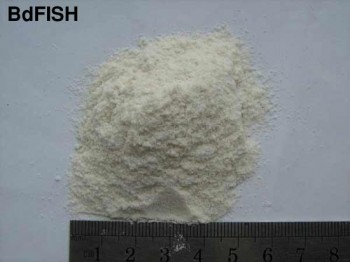
03. Rice flour
Bangla name: Chaler ata
English name: Rice flour
Source:
Paddy (Oryza sativa)
Used part:
Seed
Physical properties:
Powder form and white or whitish colored.
Availability:
Commonly available throughout Bangladesh. Found all the year round.
Application:
Used in carp polyculture mainly, used by mixing with other ingredients.
.
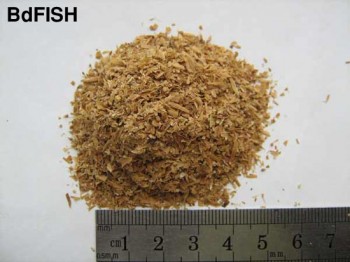
04. Rice bran
Bangla name: Chaler kura
English name: Rice bran
Source:
Paddy (Oryza sativa)
Used part:
Outer layer of seed
Physical properties:
Brownish or yellowish in color. Granular or coarse.
Chemical properties:
Moisture 11.67%; Protein 10.26%, Lipid 10.45%, Fiber 20.85%, Ash 16.4%, NFE 42.0%; and Gross energy 4235 Kcal/kg (FRI, 1989).
Availability:
Commonly available throughout Bangladesh. Peak season is in the months between December-February and April-May.
Application:
Used in carp polyculture mainly, generally applied individually or by mixing with other ingredients.
.
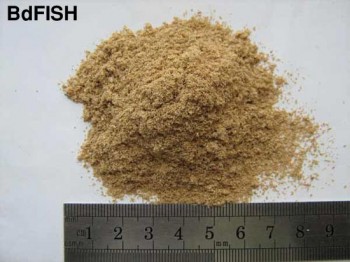
05. Rice polish
Bangla name: Chaler kura
English name: Rice polish
Source:
Paddy (Oryza sativa)
Used part:
Outer layer of seed
Physical properties:
Brownish in color. Powder in form.
Chemical properties:
Moisture 11.67%; Protein 10.26%, Lipid 10.45%, Fiber 20.85%, Ash 16.4%, NFE 42.0%; and Gross energy 4235 Kcal/kg (FRI, 1989).
Availability:
Commonly available throughout Bangladesh. Peak season is in the months between December-February and April-May.
Application:
Used in carp polyculture mainly, generally applied individually or by mixing with other ingredients.
.

06. Wheat flour
Bangla name: Gomer ata
English name: Wheat flour
Source:
Wheat plant (Triticum aestivum)
Used part:
Seed
Physical properties:
Whitish or light yellowish or brownish in color. Power form.
Chemical properties:
Moisture 9.93%; Protein 17.78%, Lipid 3.9%, Fiber 1.12%, Ash 1.6%, NFE 75.6%; and Gross energy 4488 Kcal/kg (FRI, 1989).
Availability:
Commonly available throughout Bangladesh. Peak season is in the months between April and May.
Application:
Used in carp polyculture mainly, generally applied individually or by mixing with other ingredients.
.
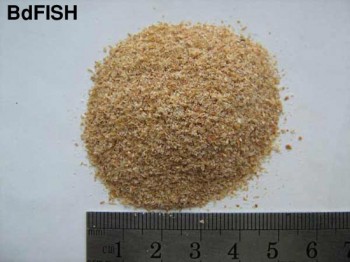
07. Wheat bran
Bangla name: Gomer bhushi
English name: Wheat bran
Source:
Wheat plant (Triticum aestivum)
Used part:
Waste part of seed after processing
Physical properties:
Yellowish colored coarse particles.
Chemical properties:
Moisture 12.68%; Protein 12.92%, Lipid 4.51%, Fiber 10.98%, Ash 5.2%, NFE 66.75%; and Gross energy 4366 Kcal/kg (FRI, 1989).
Availability:
Commonly available throughout Bangladesh. Peak season is in the months between April and May.
Application:
Used in carp polyculture mainly, generally applied individually or by mixing with other ingredients.
.
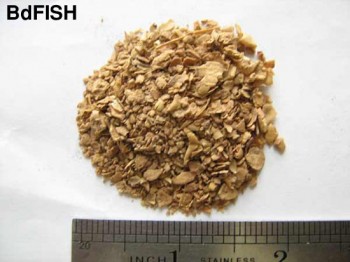
08. Soybean grits
Bangla name: Soybean Khoil
English name: Soybean grits
Source:
Soybean plant (Glycine max)
Used part:
Waste part of seed after oil processing
Physical properties:
Light yellowish in color and granular or irregular shaped fish feed ingredient.
Chemical properties:
Moisture 7.53%; Protein 23.82%, Lipid 14.83%, Fiber 18.49%, Ash 4.87%, NFE 37.39%; and Gross energy 5188 Kcal/kg (FRI, 1989).
Availability:
Commonly available Faridpur, Noakhali and some other districts of Bangladesh. Peak season is between November and January.
Application:
Used in polyculture, generally applied by mixing with other ingredients.
.
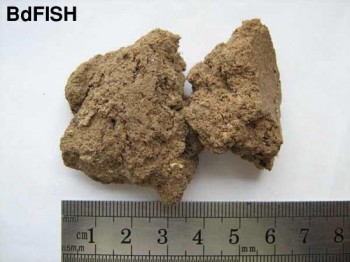
09. Sesame oil cake
Bangla name: Tiler khoil
English name: Sesame oil cake
Source:
Sesame plant (Sesamum inducum)
Used part:
Seed of the plant
Physical properties:
Blackish or brownish in color. Irregular shaped feed ingredients.
Chemical properties:
Moisture 13.13%; Protein 27.2%, Lipid 13.18%, Fiber 11.18%, Ash 13.47%, NFE 34.97%; and Gross energy 4753 Kcal/kg (FRI, 1989).
Availability:
Commonly available throughout Bangladesh. Available all the year round.
Application:
Used in carp polyculture mainly, generally applied by mixing with other ingredients.
.
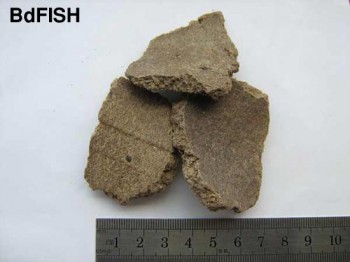
10. Mustard oil cake
Bangla name: Shorishar Khoil
English name: Mustard oil cake
Source:
Mustard plant
Used part:
Waste part of seed after oil processing
Physical properties:
Brownish or blackish to grayish colored irregular shaped fish feed ingredient.
Chemical properties:
Moisture 14.46%; Protein 30.33%, Lipid 13.44%, Fiber 12.12%, Ash 9.73%, NFE 34.38%; and Gross energy 4978 Kcal/kg (FRI, 1989).
Availability:
Found all over Bangladesh and peak season is January to March.
Application:
Used in polyculture, generally applied by mixing with other ingredients.
.
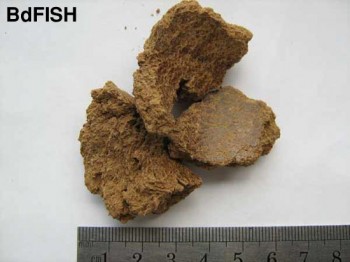
11. Coconut oil cake
Bangla name: Narikeler or Narikel khoil
English name: Coconut oil cake
Source:
Coconut plant (Cocos nucifera)
Used part:
Fruits after processing
Physical properties:
Brownish colored. Irregular shaped.
Chemical properties:
Moisture 0.53%; Protein 18.19%, Lipid 10.2%, Fiber 11.68%, Ash 6.47%, NFE 53.49%; and Gross energy 4723 Kcal/kg (FRI, 1989).
Availability:
Commonly available in coastal districts (such as Khulna, Barishal, Patuakhali etc.) of Bangladesh.
Application:
Used in polyculture, applied by mixing with other ingredients.
.

12. Lentil bran
Bangla name: Moshur / Moshurer bhushi
English name: – Lentil bran
Source:
Lentil plant (Lens culinaris)
Used part:
Outer part of seed
Physical properties:
Brownish with blackish gray colored almost powder formed ingredient.
Chemical properties:
Moisture 16.67%; Protein 19.45%, Lipid 0.47%, Fiber 28.86%, Ash 7.33%, NFE 46.89%; and Gross energy 4286 Kcal/kg (FRI, 1989).
Availability:
Commonly available in Faridpur, Jessore and some other districts of Bangladesh. Peak season is in the time between January and March.
Application:
Mainly used in carp polyculture, and usually applied by mixing with other feed ingredients.
.
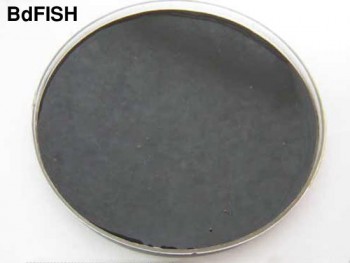
13. Molasses
Bangla name: Chita gur
English name: Molasses
Source:
Sugarcane (Saccharum officinarum)
Used part:
Juice after processing
Physical properties:
Reddish or grayish color liquid feed ingredient.
Chemical properties:
Moisture 31.67%; Protein 4.45%, Lipid 0.0%, Fiber 11.93%, Ash 11.93%, NFE 86.32%; and Gross energy 3624 Kcal/kg (FRI, 1989).
Availability:
Commonly found all over Bangladesh especially in plain land areas but seldom in hill tract areas. Peak season is November to January.
Application:
Mixed with other fish feed ingredients, as binder.
.
Reference:
- Bashu, D.N. 1989. Food and Nutrition (in Bengali), Calcutta Book House, 1/1 Bamkin Chattergy Street, Calcutta-700073, pp. 211-212.
- Das, B. 1997. Fish and Fisheries Resource Management (in Bengali), Vol. II, Bangla Academy, Dhaka-1000, pp. 27-29.
- FRI (Bangladesh Fisheries Research Institute), 1989. Survey of potential fish feed ingredients of Bangladesh on the basis of their availability and bio-chemical composition, final report, by Bhuiyan, A.K.M.A; Begum, N.N.; Begum, M.; Hoq, M.E., 69p.
Visited 8,700 times, 1 visits today | Have any fisheries relevant question?
